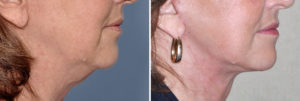
In reality, however, this is not what a facelift is. A facelift is a rather poorly named surgical procedure. More accurately, it should be called a neck or neck-jowl lift for this is what it actually does. A facelift affects only the lower third of the face and does nothing for the upper and middle thirds of the face. It helps re-create a sharper neck angle and gets rid of those saggy jowls. When a facelift is done in isolation, there is no bruising or swelling around the eyes or the rest of the face! Many times, however, patients wants a more complete facial improvement and then simultaneous procedures involving the eyes, nose, or mouth may be done with a facelift, the effect of which is to more closely mimic the images that patients originally imagined a facelift to be.
When I do a facelift only, patients do have a head dressing and surgical drains for the first night after surgery. However, these are removed the next day and replaced with a small chin strap that they wear for the rest of the week. Patients may shower and wash their hair the next day. Short of bending over or strenuous exercise there are no specific activity restrictions. Recovery is really of a social nature, rather than that of a physical one. There is virtually no pain and only some mild tenderness around the ears. You really will look pretty from a facelift only procedure in seven to ten days.
Undergoing a facelift should not be viewed, therefore, as a scary or arduous undertaking. Most patients will tell you that it was a lot easier than they had imagined. Many times patients will want a more complete amount of facial improvement and surgery on the eyes (blepharoplasty) which would be the most common plastic surgery procedure done with lower facial rejuvenation. This is because most patients feel that the eyes and neck are their top two facial aging concerns they want improved.
Dr. Barry Eppley
Indianapolis, Indiana


